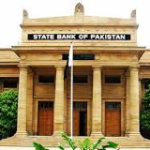 The recently released FY14 Annual Report of State Bank of Pakistan (SBP) has highlighted that the overall macroeconomic improvement in the previous fiscal year was underpinned by increase in foreign exchange reserves of the country and lower than expected inflation. While revival of economic activity provides a strong platform for continued reforms, the central bank has pointed towards shortcomings on the energy front (need for improved transmission & distribution) and concerns for private sector credit offtake considering banks’ penchant for investing in GoP securities.
The recently released FY14 Annual Report of State Bank of Pakistan (SBP) has highlighted that the overall macroeconomic improvement in the previous fiscal year was underpinned by increase in foreign exchange reserves of the country and lower than expected inflation. While revival of economic activity provides a strong platform for continued reforms, the central bank has pointed towards shortcomings on the energy front (need for improved transmission & distribution) and concerns for private sector credit offtake considering banks’ penchant for investing in GoP securities.
At the same time, the SBP has undertaken sector-specific analyses calling for: 1) gas transfer from the fertilizer sector to the power sector and 2) allowing import of new cars while encouraging increase in localization levels and fresh models in the sub-1000cc category. The SBP report paints a picture of cautious optimism on the macroeconomic front paving way for reduction in discount rate in the near term.
The SBP acknowledges that FY14 was a much improved year for the economy, underpinned by an increase in foreign exchange reserves, appreciation and then stability in the exchange rate, a reduction in the fiscal deficit, lower than expected inflation and pickup in private sector credit. While energy shortages could confine FY15 GDP growth to less than 5%, the SBP expects CPI to average 6.5%-7.5%. Within this backdrop, monetary easing will likely continue across the next six months, boding well for overall equity market valuations – the KSE-100 Index’s P/E has averaged 9.0x (vs. 8.3x at present) during times of single-digit interest rates. On the flipside, while hefty PIB holdings may shield banks’ earnings in the near-term, there is significant reinvestment risk over the medium-term; considering total debt/GDP has crossed 60%, ongoing NFA increase should be complemented by lower GoP borrowing, implying the need for a strategic rethink towards private sector lending. Analysts expect divergence among banks’ multiples with relative winners to be banks with stronger balance sheets, diversified income streams, superior asset quality and better cost efficiency.
Although, the GoP has taken steps to reduce power sector subsidies, the results thus far remain short of expectations, highlighted by the lack of reforms in Gencos/Discos, the adverse impact of untargeted subsidies for households and a depleting transmission and distribution (T&D) infrastructure. SBP has emphasized the need to address T&D losses and optimize the consumer mix before adding new capacities. Regarding circular debt, the SBP believes the outstanding stock of circular debt, estimated more than half a trillion rupees will likely be paid this year or it will risk undermining the supply chain. Initiatives proposed include the diversifying of the power generation mix to coal, tariff rationalization to reduce wastage, optimizing the consumer base to promote commercial users, and allocating gas to base load power generation.
The SBP has taken a hard line against the fertilizer sector, suggesting that gas be diverted to power plants. As per the central bank, this would have yielded net fiscal savings of Rs163 billion in FY14 primarily due to the reduction in power subsidy, lower import of furnace oil and a higher realized price. This may entail revisiting of gas supply agreements with fertilizer companies which may not be feasible. Analysts expect fertilizer sector to remain lackluster during 2015 due to gas shortages.
By comparing the Pakistani and Indian auto sectors, the SBP has flagged that Pakistani consumers are not as well off when compared to Indian consumers as producers in Pakistan have significant market power and are also protected from international competition. As such, the SBP has endorsed CCP assessment that calls for allowing import of new cars. Although the central bank supports incentives to enhance localization levels, consistent policies, making all efforts to attract FDI in auto sector and encouraging production of fuel efficient cars in less than 1000cc category. While 2015 is likely to be a strong year for the Auto sector, the industry remains vulnerable to policy shocks across the medium-term.